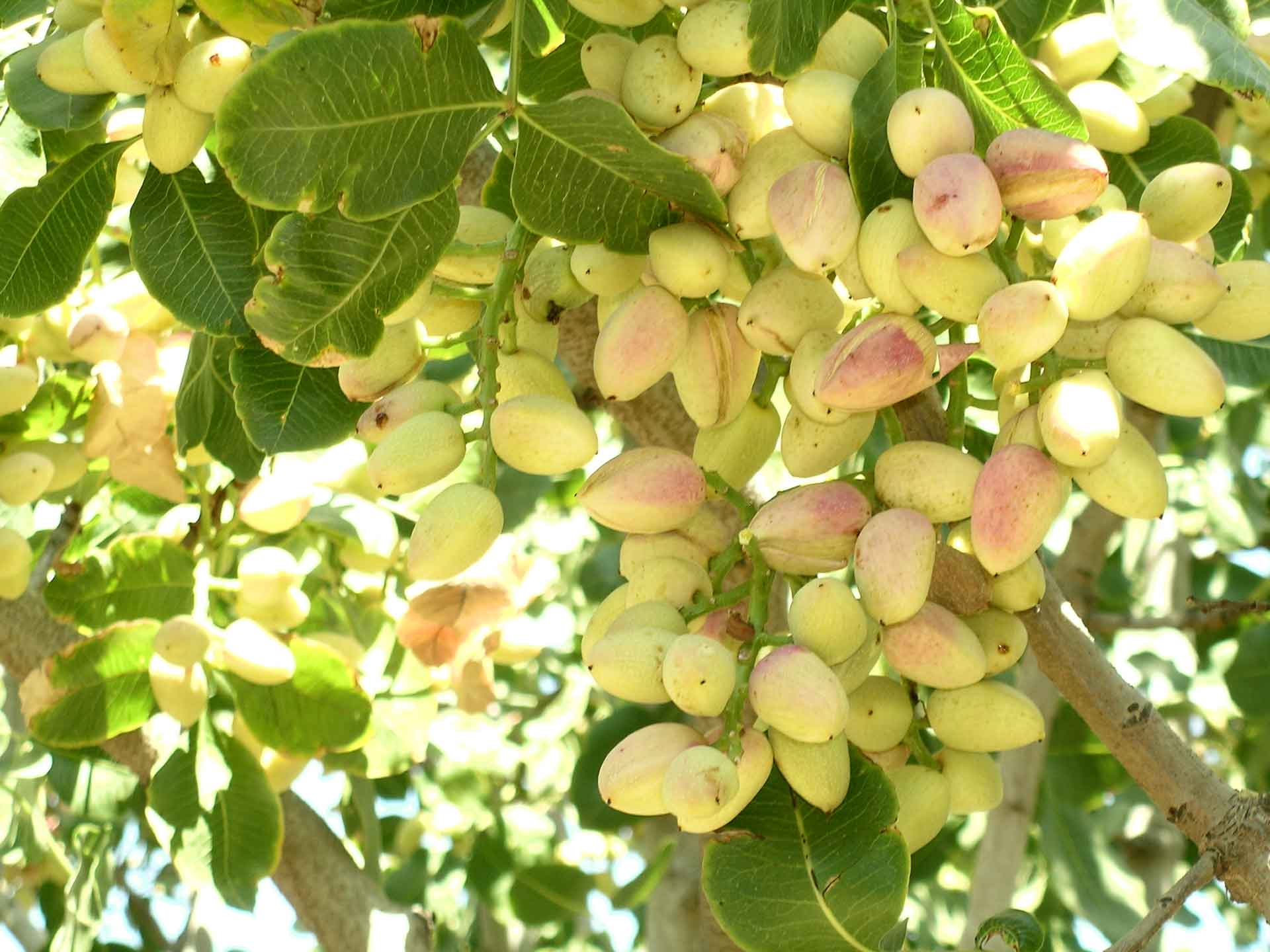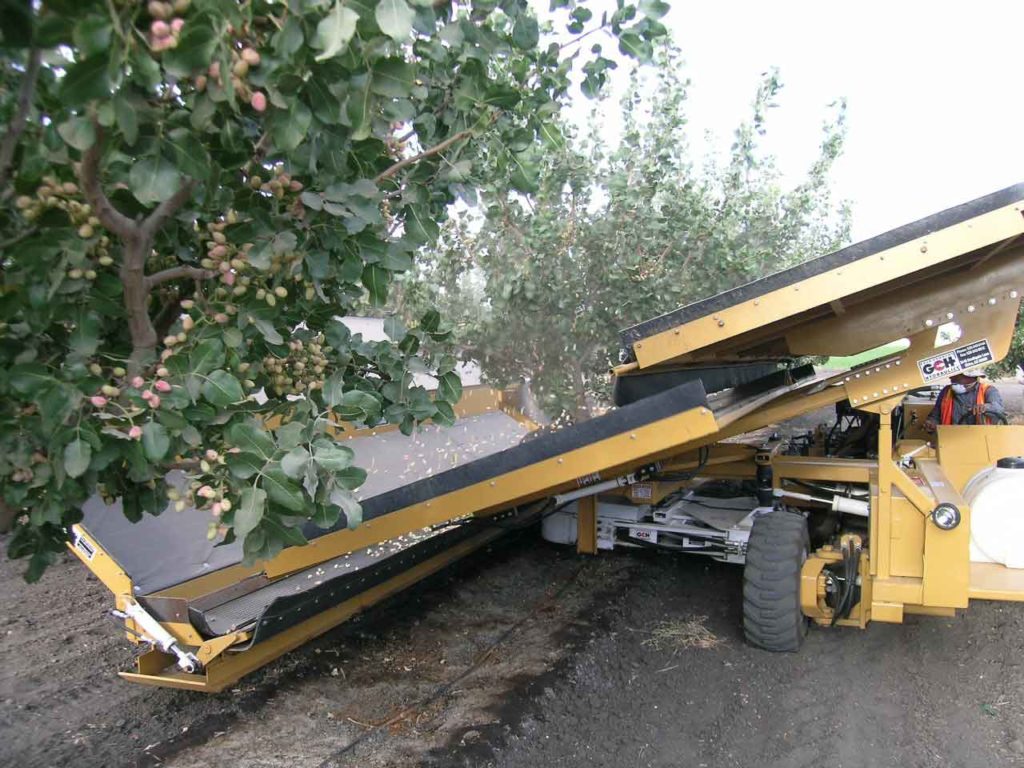
Prior to the release of the cultivar Golden Hills, pistachio growers in the San Joaquin Valley (SJV) of California were accustomed to harvesting a single female cultivar named Kerman. Since Kerman was the only female cultivar that most growers had any experience with, the way Kerman was harvested became synonymous with how pistachios, in general, should be harvested. However, different cultivars have “individualities” that should be addressed to make a harvest more successful. What makes for a successful Kerman harvest is not, necessarily, that which makes for a successful Golden Hills harvest and vice versa. Although Golden Hills was released from the University of California breeding program to the pistachio industry in 2005, acreage did not begin to increase appreciably until 2012, when approximately 3000 aces were planted. Assuming all goes well in orchard establishment, pistachio require approximately five or six years to produce a crop worth harvesting. If we do the math, only in the past few years have significant numbers of Golden Hills orchards been harvested. With 65,000 acres of Golden Hills in the ground now, the objective of identifying practices for a more efficient and productive harvest of Golden Hills is well-worth pursuing.
Randomized and replicated research trials have demonstrated that trees just coming into bearing will harvest later than mature bearing trees. Since many of the older Golden Hills trees in the SJV are just coming into bearing, or have been bearing for just a few years, they will tend to harvest closer in time to older Kerman trees. However this will not continue. A finished harvest for a mature Golden Hills orchard is completed 10 days to two weeks before a mature Kerman orchard, if growing in the same valley location.
Harvest Golden Hills in a Timely Manner
It is even more important to harvest Golden Hills when nuts are first ready, than it is for Kerman. Nuts of Golden Hills will not “store” on the tree while awaiting harvests as long or well as those of Kerman. Almond growers sometime use the term “dry down” to refer to the process of drying out the orchard, in particular the orchard floor, prior to harvest. Unless you have the soggiest, highest saturation-percentage soils in the SJV, if you want clean, split nuts the term “dry down” is not applicable to pistachio production, especially so for growers of Golden Hills. Air temperatures are hot when Golden Hills is ready for harvest. The trees will be transpiring at very high rates. Hot temperatures will age mature nuts more rapidly than late summer or fall temperatures, and negative quality issues such as the hull adhering to the nutshell and dark shell staining will occur more rapidly. For many blocks, if you cannot get in and harvest the nuts within two or three days after shutting the water off, you need to fix the leaks in the irrigation system, correct the irrigation distribution inefficiencies, or adjust irrigation scheduling. If wet fields are not keeping you from harvesting but harvests have been late, it might be time for a serious talk with your harvest contractor, or if acreage warrants, maybe purchasing some harvesting equipment may be a possibility. There is no reason to have a “bone dry” root-zone prior to or after harvest. Heat stressed trees through and after the harvest period will cost you money, in terms of both nut quality and yield, this year and next year.
Timing the Golden Hills Harvest
Once a majority of the hulls slit harvest can begin. The greenish “stick-tight” hulls are most likely blank nuts (that is, do not have a kernel). Do not use hull tatter (that is, the early disintegration of the hulls) to gauge harvest with Golden Hills. The hull of Golden Hills nuts do not tatter nearly to the degree as those of Kerman when ready for harvest. Most of the nuts will be split and ready for harvest even if many of the hulls remain intact. If you wait until most of Golden Hills’ hulls have tattered, you are harvesting too late. An advantage of intact hulls at harvest may be reduced navel orangeworm infestation compared to the nuts under the tattered hulls of Kerman.
Golden Hills is Amenable to a “Single Shake”
Pistachio nuts never touch the ground. Machinery is used which shakes the tree trunk, catches the falling nuts and moves them to bins or vehicles for transport to trailers headed for the processing plant. An individual harvest, across the orchard, is called, commonly, a “shake”. For the purpose of this article, the definition of a double shake is when an orchard is harvested twice and approximately equal weights of nuts are harvested within each of the two shakes. A double shake is composed of a light, initial shake (commonly called a “bump” shake in which the rachis of the cluster remains attached to the tree) and a hard shake roughly 10 days or more later. Using this nomenclature, if more than 90 percent of the total nut load is removed during the first shake, the following shake is more of a “sanitation” shake and falls outside this definition of a double shake.
Bloom and harvest evaluations over many years have demonstrated that the relatively short bloom period for Golden Hills translates to more even nut maturity across the tree at harvest than is the case for Kerman or the cultivar Lost Hills. Because of the more even maturity of nuts across the tree, a double shake is unnecessary for Golden Hills, unless bloom was extended abnormally due to poor winter chilling or cool harvest conditions. For mature trees, when the hulls of the most advanced nuts begin to slip and are ready for harvest, waiting an additional eight to ten days, will usually allow the harvest of 95 percent or more of the nuts in a single shake. Do not rush harvest. If you shake the first nuts early for Golden Hills, when only 50 percent are ready, you will need to come back in a week or less to remove the remaining nuts and maintain nut quality. Most growers are not prepared to come back to the same orchard in a week or less for a double shake and nut quality can decline rapidly for a delayed second shake. By waiting a few more days for the first shake, until 95 percent or more of the nuts are ready, most of the crop will be at the processor before the first shake of Kerman, and suffer little if any loss in terms of nut quality even if compared to the results from two well-timed separate shakes.
If mature ‘Golden Hills’ trees are being harvested at the same time as Kerman in a given location, probably harvest timing did not go as well as it could have. Even if a second shake of mature ‘Golden Hills’ is necessary, normally, it will be completed before the first shake of Kerman for trees of the same age in the same location.
Assuming the nuts were processed at the plant in a timely manner, a high percentage of nuts having the hull adhere to the shell, or with dark stains on the shell, signifies that the harvest was later than it should have been. If only the percentage of adhering hull is high, and the percentage of darkly stained shells is low, it suggests that the harvest was too early.

Post-Harvest Irrigation
The yield and nut quality data for Golden Hills in our studies were obtained in small trials within larger blocks of ‘Kerman’. Golden Hills, after harvest, was irrigated based on the full irrigation requirements for Kerman, which had not yet been harvested. Thus, Golden Hills, typically, received a generous post-harvest irrigation.
The pistachio tree has been shown to produce and store significant quantities of carbohydrate in the fall for future nut production and growth next year. For optimal yields and if green leaves are present, continue to meet water requirements of the mature trees after harvest (which may be an additional month or six weeks). Attempting to institute post-harvest regulated deficit irrigation on Golden Hills, which, usually, is harvested by the end of August or early September in the southern SJV, may produce yield and nut quality results quite different from the fully irrigated post-harvest trees in our small experimental trials.















